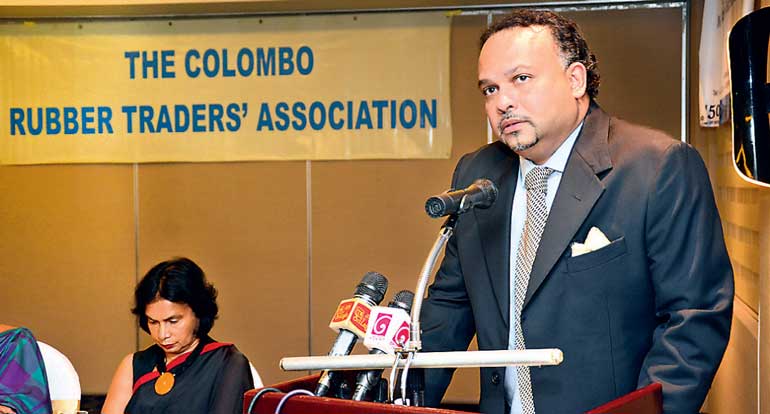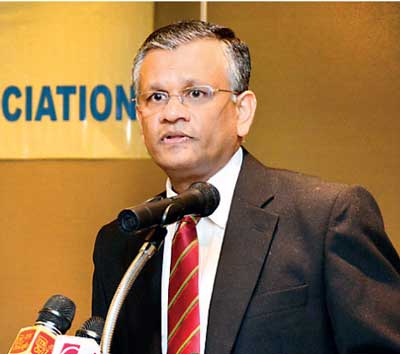Tuesday Nov 26, 2024
Tuesday Nov 26, 2024
Wednesday, 3 August 2016 00:02 - - {{hitsCtrl.values.hits}}

Plantation Industries Minister Naveen Dissanayake – Pic by Krishan Ranasinghe
By Charumini de Silva
Plagued by weak international prices and low productivity, the Government is betting on a newly formulated ‘Master Plan’ to revive the rubber industry with private sector support that revolves on establishing new 22,000-hectare plantations around the country including the north and east.
“Although rubber prices are falling there are other alternatives and strategies that we can adapt hopefully to revive the rubber sector,” Plantation Industries Minister Navin Dissanayake said while addressing the 97th AGM of the Rubber Traders Association last Friday.
“We have now got an allocation of Rs. 100 million for the start to setup the office and we have located it in Battaramulla to move the Rubber Department as well as the Rubber Secretariat which is a partnership between the Government and the private sector,’’ Dissanayake explained.
According to the Minister, the Master Plan consists of 24 projects and 10 programs and each project will be led by a work group the Minister will appoint. The Cabinet has approved the signing of an MoU, which will be finalised at the public launch of the Master Plan. However, specific dates were not announced by the Minister.
The plan covers the period from 2016-2025 and centres on starting 22,000-hectare rubber plantations in non-traditional areas such Moneragala, Ampara, Vavuniya, Mullaitivu and Hambantota in partnership with the private sector. The Minister called on companies to present their proposals to him for consideration. Once vetted, the ventures will be developed as public-private partnerships.
Commenting on the global downturn of rubber prices, he pointed out that the industry should face the cyclical nature by increasing quality and productivity.
Rubber industry value chains consisted of two major interdependent sectors which include raw rubber production and rubber-based product manufacturing. With the local production downfall, imported rubber increased to 29,220 MT in 2014 from 11,150 MT in 2013.
“In our context the integration of the two sectors can possess a certain comparative advantage to each other rather than trying to outsmart each other,” he said.
Dissanayake suggested that trading companies should explore the opportunities in integrating supply links to establish sustainable linkages.
He added that although it was a small player in the global arena in terms of raw rubber and rubber products manufacturing, Sri Lanka could still remain competitive globally by adopting the twin strategy of product differentiation instead of offering timeworn commodities and enhancing productivity while reducing the cost of production at all levels to set the path to make the country the rubber hub of Asia.
Dissanayake backed Government plans to liberalise the economy saying, “Rubber should be allowed to be imported for re-exports without there being any hindrances whatsoever, like what is happening in Singapore and Dubai.”
“Our research staff in all four institutions are tremendously underpaid. It seems to be an inherent DNA structure problem in our country where research or analysis is not favoured or encouraged,” said Dissanayake in reference to the state of the premier plantation R&D institutions in the country.
He added that as a result of financial constraints in the industry and low cooperation from the Treasury, R&D efforts were consistently undermined and underinvested.
He also commented that the lack of market orientation had made the Rubber Research Institute (RRI) more complacent and ineffective. “RRI has long been lagging behind in some market trends,” he asserted.
He also revealed that the research institution has difficulty in retaining productive employees as they were lured by the private sector’s more attractive salary packages.
In 2014, the rubber sector declined for the third consecutive year with rubber production dropping by 24.4%.
The Minister acknowledged that the Government needed to create an enabling environment with appropriate infrastructure, conducive policies and effective institutions to turnaround the industry.
 The low price environment prevailing in the rubber industry has left exporters in the country in quite a predicament, Colombo Rubber Traders Association Chairman Sunil Poholiyadde said.
The low price environment prevailing in the rubber industry has left exporters in the country in quite a predicament, Colombo Rubber Traders Association Chairman Sunil Poholiyadde said.
Noting that rubber prices had historically experienced deep fluctuations, he recalled: “In 1998 prices declined for about four to five years where the rubber market fell to a low price of Rs. 40. By 2004 and 2006 the market started rising again with the improvement of oil prices. By the end of this phase it peaked to a record price of Rs. 2,600.”
Poholiyadde stated that the ban of weedicides had negatively affected the industry. He also urged the reinstatement of the fertilizer subsidy so producers could grow more trees to ensure that the industry produced enough rubber to cater to demand when it bounced back.
“Growers are the backbone of this industry and I think we should put all our efforts into protecting them. Rubber cultivators are concerned about the banning of weedicides as well as the lifting of the fertilizer subsidy. I earnestly request the Minister to look into these two aspects at least to ensure that our rubber industry expands,” he added.
He also suggested that stakeholders look at more value additions as it was going to be the way forward for the industry.